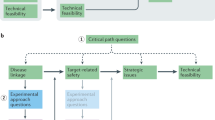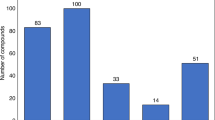Abstract
This paper reviews models of academic–pharmaceutical industry collaboration and debates the value of such partnerships so that those contemplating an alliance can reflect a priori on the purpose, nature and process that will provide a constructive outcome. The scope is confined to the biomedical discipline, because collaborations in other fields, such as physics and engineering, have not suffered as a result of the concerns associated with biomedicine.
This is a preview of subscription content, access via your institution
Access options
Subscribe to this journal
Receive 12 print issues and online access
$209.00 per year
only $17.42 per issue
Buy this article
- Purchase on Springer Link
- Instant access to full article PDF
Prices may be subject to local taxes which are calculated during checkout


Similar content being viewed by others
References
Ross, R. Academic research and industry relationships. Clin. Investigat. Med. 9, 269–272 (1986).
Blumenthal, D. Academic–industrial relationships in the life sciences. N. Engl. J. Med. 349, 2452–2459 (2003).
Weiner, C. Patent and academic research: historical case studies. Sci . Technol. Human Values 12, 50–62 (1987).
Swann, J. Co-operative Research in the 20th Century America (Johns Hopkins Univ. Press, Baltimore, 1988).
Angell, M. Excess in the pharmaceutical industry. CMAJ 171, 1451–1453 (2004).
Kassirer, J. P. These two make quite a team. Washington Post B1,B5 (2004).
Triggle, D. Patenting the sun: enclosing the scientific commons and transforming the university — ethical concerns. Drug Dev. Res. 63, 139–149 (2005).
Washburn, J. University, Inc: The Corporate Corruption of Higher Education (Basic Books, New York, 2005).
Blumenthal, D., Gluck, M., Louis, K. S., Stoto, M. A. & Wise, D. University-industry research relationships in biotechnology: implications for the university. Science 232, 1361–1366 (1986).
Mainschein, J. Why collaborate? J. Hist. Biol. 26, 167–183 (1993).
Pfizer Public Medical & Academic Partnerships (MAP) Grants [online], <http://www.promisingminds.com/GrantsProgType.aspx?ProgID=405&ProgAreaID=22&ProgTypeID=4> (2005).
Roche Postdoctoral Fellowships [online], <http://paloalto.roche.com/careers/PostDocsFellow.html> (2001).
Roche Symposium for Leading Chemists of the Next Decade <http://euroweb.roche.com/symposium/index.htm> (2005).
Roche Symposium for Leading Bioscientists of the Next Decade http://euroweb.roche.com/biosymposium/ (2005).
MIT Industrial Liason Program [online], <http://ilp-www.mit.edu/display_page.a4d?key=H1> (2004).
Strathclyde Institute for Drug Research [online], <http://www.sidr.org/> (2005).
Massachusetts Institute of Technology. MIT and Amgen announce biological research agreement [online], <http://web.mit.edu/newsoffice/1994/amgen-0330.html> (2005).
Biotechnology and Biological Sciences Research Council. How to get funding. [online], <http://www.bbsrc.ac.uk/funding/fellowships/Welcome.html> (2005).
National Health and Medical Research Council. NHMRC Industry Fellowships [onlien], <http://www.ro.mq.edu.au/fund/nhmrc/IndustryFellow/indflyer.pdf> (2002).
Scripps Research Institute. NIH funds Scripps Research–Novartis collaboration to target new treatments for depression and nicotine addiction [online], <http://www.scripps.edu/newsandviews/e_20031208/markou.html> (2005).
Genetech, Inc. Corporate overview [online], <http://www.gene.com/gene/about/> (2005).
Moses, H. & Martin, J. B. Academic relationships with industry: a new model for biomedical research. JAMA 285, 933–935 (2001).
Council on Governmental Relations.The Bayh–Dole Act: A Guide to the Law and Implementing Regulations [online], <http://www.cogr.edu/docs/Bayh_Dole.pdf> (1999).
Krimsky, S. & Baltimore, D. The ties that bind or benefit. Nature 283, 130–131 (1980).
Bearn, A. G. The pharmaceutical industry and academe: partners in progress. Am. J. Med. 71, 81–88 (1981).
Molinoff, P. B. Common to both academia and industry: the challenge of discovery. An interview with Perry Molinoff. Mol. Interv. 1, 78–83 (2001).
Gelijns, A. C. & Thier, S. O. Medical innovation and institutional interdependence: rethinking university-industry connections. JAMA 287, 72–77 (2002).
Alper, J. Drug development. Biotech thinking comes to academic medical centers. Science 299, 1303–1305 (2003).
Gale, E. A. Between two cultures: the expert clinician and the pharmaceutical industry. Clin Med 3, 538–541 (2003).
Reichert, J. M. & Milne, C. P. Public and private sector contributions to the discovery and development of 'impact' drugs. Am. J. Ther. 9, 543–55 (2002).
Maxwell, R. A. & Eckhardt, S. B. Drug Discovery: A Casebook and Analysis (Humana, New Jersey, 1990).
Kneller, R. The origins of new drugs. Nature Biotechnol. 23, 529–530 (2005).
Nathan, D. G. & Weatherall, D. J. Academic freedom in clinical research. N. Engl. J. Med. 347, 1368–1371 (2002).
Rosenberg, S. A. Secrecy in medical research. N. Engl. J. Med. 334, 392–394 (1996).
Bekelman, J. E., Li, Y. & Gross, C. P. Scope and impact of financial conflicts of interest in biomedical research: a systematic review. JAMA 289, 454–465 (2003).
Callaham, M. L., Baxt, W. G., Waeckerle, J. F. & Wears, R. L. Reliability of editors' subjective quality ratings of peer reviews of manuscripts. JAMA 280, 229–231 (1998).
Braod Institute. Broad and Novartis announce collaboration to uncover genetic basis for type 2 diabetes [online], <http://www.broad.mit.edu/media/2004/novartis_1027.html> (2004).
Lawler, A. Diabetes research. Broad–Novartis venture promises a no-strings, public gene database. Science 306, 795 (2004).
Axelrod, R. M. The Evolution of Cooperation (Basic Books, New York, 1984).
Cho, M. K., Shohara, R., Schissel, A. & Rennie, D. Policies on faculty conflicts of interest at US universities. JAMA 284, 2203–2208 (2000).
Mueller, K. in Proceedings of the Seminar of the Magna Charta Observatory: Managing University Autonomy 115–127 (Boronia Univ. Press, 2004).
Meyer-Krahmer, F. & Schmoch U. Science-based technologies: university-industry interactions in four fields. Research Policy 27, 835–851 (1998).
Prager, D. J. & Omenn, G. S. Research, innovation, and university-industry linkages. Science 207, 379–384 (1980).
Merton, R. Theoretical and Empirical Investigations (Univ. Chicago Press, Chicago, 1974).
Boldrin, M. & Levine, D. K. The economics of ideas and intellectual property. Proc. Natl Acad. Sci. USA 102, 1252–1256 (2005).
Ridley, R. & Toure, Y. Winning the drugs war. Nature 430, 942–943 (2004).
Fidock, D. A., Rosenthal, P. J., Croft, S. L., Brun, R. & Nwaka, S. Antimalarial drug discovery: efficacy models for compound screening. Nature Rev. Drug Discov. 3, 509–520 (2004).
Sharp, D. Not-for-profit drugs — no longer an oxymoron? Lancet 364, 1472–1474 (2004).
Kremer, M. & Glennerster, R. Strong Meedicine: Creating Incentives for Pharmaceutical Research on Neglected Diseases (Princeton Univ. Press, Princeton, 2004).
Acknowledgements
The authors would like to acknowledge the invaluable discussions held with G. Gromo (Switzerland), C. Johnston (Australia), R. Flower (UK), P. Vanhoutte (Hong Kong), A. Harvey (Scotland) and B. Duncan (Scotland). We also acknowledge input from E. Jones, A.-M. Jefferies and M. Vincent from the Baker Heart Research Institute for their background research efforts.
Author information
Authors and Affiliations
Corresponding author
Ethics declarations
Competing interests
J.D.F. receives consulting fees for advising on drug research strategy and due diligence exercises from several pharmaceutical and venture capital companies, but no equity in the companies for which he consults. J.M. is a full-time employee of Hoffmann-La Roche.
Rights and permissions
About this article
Cite this article
Chin-Dusting, J., Mizrahi, J., Jennings, G. et al. Finding improved medicines: the role of academic–industrial collaboration. Nat Rev Drug Discov 4, 891–897 (2005). https://doi.org/10.1038/nrd1879
Published:
Issue Date:
DOI: https://doi.org/10.1038/nrd1879
This article is cited by
-
Feasibility of activity-based expert profiling using text mining of scientific publications and patents
Scientometrics (2020)
-
‘Stealth’ corporate innovation: an emerging threat for therapeutic drug development
Nature Immunology (2019)
-
Reflections on the Future of Pharmaceutical Public-Private Partnerships: From Input to Impact
Pharmaceutical Research (2017)
-
Knowledge transfer in academia: an exploratory study on the Not-Invented-Here Syndrome
The Journal of Technology Transfer (2012)
-
Can literature analysis identify innovation drivers in drug discovery?
Nature Reviews Drug Discovery (2009)



